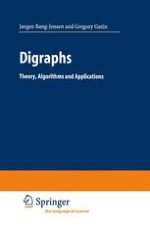2002 | OriginalPaper | Chapter
Orientations of Graphs
Authors : Jørgen Bang-Jensen, PhD, Gregory Gutin, MSc, PhD
Published in: Digraphs
Publisher: Springer London
Included in: Professional Book Archive
Activate our intelligent search to find suitable subject content or patents.
Select sections of text to find matching patents with Artificial Intelligence. powered by
Select sections of text to find additional relevant content using AI-assisted search. powered by
The purpose of this chapter is to discuss various aspects of orientations of (multi)graphs. There are many ways of looking at such questions. We can ask which graphs can be oriented as a digraph of a certain type (e.g. a locally semicomplete digraph). We can try to obtain orientations containing no directed cycles of even length, or no long paths. We can try to relate certain parameters of a graph to the family of all orientations of this graph (e.g. what does high chromatic number imply for orientations of a graph). We can also look for conditions which guarantee orientations with high arc-strong connectivity or high in-degree at every vertex, etc. There are hundreds of papers dealing with orientations of graphs in one way or another and we can only cover some of these topics. Hence we have chosen some of those mentioned above. Finally we also study briefly the theory of submodular flows which generalizes standard flows in networks and turns out to be a very useful tool (not only theoretically, but also algorithmically) for certain types of connectivity questions as well as orientation problems. We illustrate this by applying the submodular flow techniques to questions about orientations of mixed graphs as well as to give short proofs of the Lucchesi-Younger Theorem and Nash-Williams’ orientation theorem. We recall that n and m usually stand for the number of vertices and arcs (edges) of the (di)graph in question.
